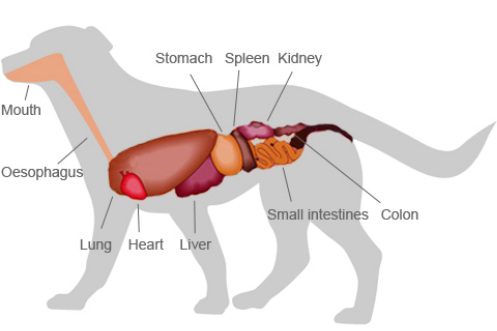
This Organ Systems module has five units of instruction that focus on the main classes of functions that a body must perform. Rather than just naming organs of the body and what they do, we present a perspective on the body as a coordinated group of systems that must do certain things correctly in order to survive and thrive. Clicking on the unit titles will take you to the topic. These units include an interactive PowerPoint presentation, pre- and post- tests in multiple formats for varied delivery methods, a self-study game, note-taking outline, and multiple activities to reinforce and enrich the content of the lessons.
Standards Aligned: Each unit is aligned to the NGSS and TEKS for both middle school science and high school biology, as appropriate for the lesson content. A document included with each unit provides the standards for that unit.
Each module has a “Hazards” section that presents environmental hazards (such as food poisoning, sunburn, smoking, and so on).
You may go through the units in any sequence, but we suggest first exploring Unit 1, Bodily Defenses.
Each instructional unit includes topics on:
- Introduction
- “Why Does It Matter” to explain the significance of the subjects
- “How We Know” to explain how under-standing develops
- “What We Know” to summarize the main facts
- “Story Time” a short bio sketch on famous scientists, emphasizing, where possible, their childhood
- Activities, Assignments for hands-on learning
- Major Hazards
- Interactive self-study game
- Interactive flash cards for self-study
The Basic Concepts
Certain key needs must be satisfied in order for organisms to survive. Once you get beyond the single celled animal, cells must organize in some way to function as a single organism. The most primitive way of doing this is to form a colony in which all cells do the same thing; they just live together. Corals are a good example of this.
In higher animals, however, cells become specialized (scientists call it “differentiated”) into certain type of tissue. Examples include skin, muscle, bone, blood, and so on. Then tissues are formed during embryonic development into certain organs. Examples include stomach, liver, brain, lungs, and so on.
Key processes:
- Gas exchange: needed to provide the oxygen needed for energy production in all cells and to remove the carbon dioxide that all cells produce as a waste product of energy production.
- Nutrients: needed to provide chemical sources for energy and for building and maintaining the parts of a cell.
- Defense: against undue loss of water and against foreign invaders, such as viruses and bacteria
- Detoxification: neutralize or destroy toxins that get into the body or are normal products of cellular chemical reactions
- Coordination and Control: needed for consciousness, learning and memory, movement, emotions, and to detect environmental changes.
Bodily Defenses
Digestion
Detoxification
Gas Exchange
Coordination & Control
Bodily Defenses
Presentation
Notes
Activities
- Activity 1 – Skin Observations: Download Document or View Google Doc
- Activity 2 – Ready, set, infect!: Download Document or View Google Doc
Teacher Materials
- TEKS and NGSS Document: Download Document
- Notes outline key: Download Document or View Google Doc
- Activity Sheets: Download Document
- Pre-Test Presentation: Download PPT or View Google Slides
- Post-Test Presentation: Download PPT or View Google Slides
- Pre and Post Test Keys: Download Doc or View Google Doc
Digestion
Presentation
Notes
Activities
- Activity 1 – The Story of Digestion: Download Document or View Google Doc
- Activity 2 – Let’s Eat!: Download Document or View Google Doc
- Activity 3 – Digestive System Diagram: Download Document or View Google Doc
Teacher Materials
- TEKS and NGSS Document: Download Document
- Notes outline key: Download Document or View Google Doc
- Activity Sheets
- Teacher Instructions: Download Document
- Activity 1 – Answer Key: Download Document or View Google Doc
- Activity 2 – Answer Key: Download Document or View Google Doc
- Pre-Test Presentation: Download PPT or View Google Slides
- Post-Test Presentation: Download PPT or View Google Slides
- Pre and Post Test Keys: Download Doc or View Google Doc
Detoxification
Presentation
Notes
Activities
- Activity 1 – What’s the Right Dose?: Download Document or View Google Doc
- Activity 3 – Kidney Dissection: Download Document or View Google Doc
Teacher Materials
- TEKS and NGSS Document: Download Document
- Notes outline key: Download Document or View Google Doc
- Activity Sheets: Download Document
- Pre-Test Presentation: Download PPT or View Google Slides
- Post-Test Presentation: Download PPT or View Google Slides
- Pre and Post Test Keys: Download Doc or View Google Doc
Gas Exchange
Presentation
Notes
Activities
- Activity 1 – Build Your Own Spirometer!: Download Document or View Google Doc
- Activity 3 – Blow it Up!: Download Document or View Google Doc
- Activity 4 – Breathing Easy: Download Document or View Google Doc
Teacher Materials
- TEKS and NGSS Document: Download Document
- Notes outline key: Download Document or View Google Doc
- Activity Sheets: Download Document
- Activity 3 Data collection Tables: Download Excel Document or View Google Spreadsheet
- Pre-Test Presentation: Download PPT or View Google Slides
- Post-Test Presentation: Download PPT or View Google Slides
- Pre and Post Test Keys: Download Doc or View Google Doc
Coordination & Control
Presentation
Notes
Activities
- Activity 1 – Brain Size: Download Document or View Google Doc
- Activity 2 – Conditioned Learning: Download Document or View Google Doc
- Activity 3 – Memory Consolidation: Download Document or View Google Doc
Teacher Materials
- TEKS and NGSS Document: Download Document
- Notes outline key: Download Document or View Google Doc
- Activity Sheets: Download Document
- Pre-Test Presentation: Download PPT or View Google Slides
- Post-Test Presentation: Download PPT or View Google Slides
- Pre and Post Test Keys: Download Doc or View Google Doc

Teacher's Note
These modules are designed to be used by middle and high school students. The interactive PowerPoint documents are developed to be student-centered and self- guided. The note-taking outlines go along with the PowerPoint presentations and focus on materials that are required in the NGSS and TEKS standards. The pre- and post- tests are developed to prepare students for the types of questions that they might encounter on standardized tests. There are many higher level questions included in the presentations and the activities that encourage students to critically analyze the content. Full teacher instructions are included in each unit.
